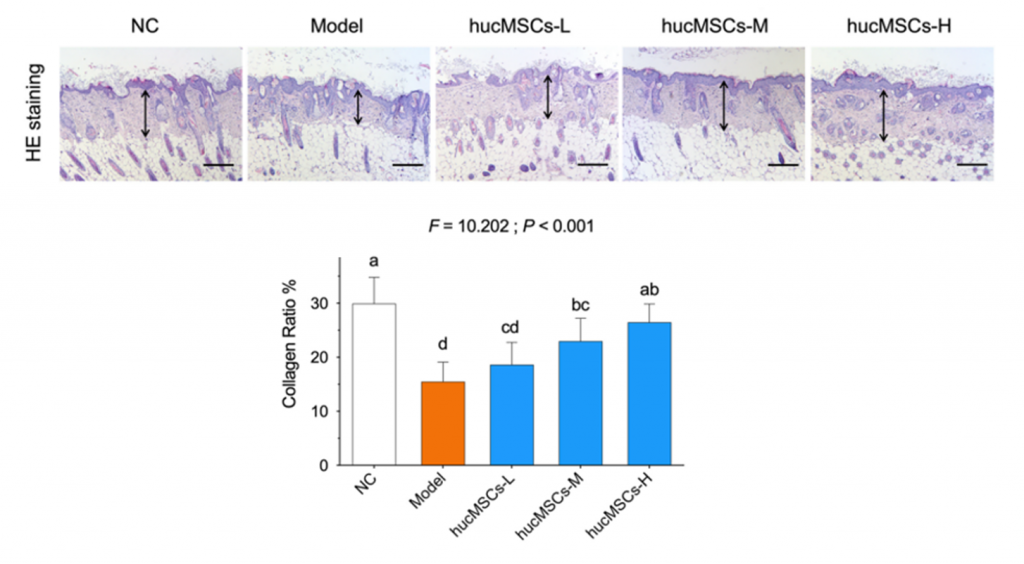Key Points:
- Stem cell treatment removes wrinkles, smooths skin, increases skin thickness, and enhances collagen production in mice with aged-skin.
- Treatment with stem cells improves wound healing in human skin tissue by limiting the accumulation of senescent cells – growth-arrested cells linked to aging.
- The beneficial effects of stem cell therapy are mediated by alleviating oxidative stress — the damage caused to cells by harmful molecules called reactive oxygen species (ROS).
Our stem cells harness the power of regeneration, capable of rebuilding organs like bone, skeletal muscle, and skin. Since organs like our skin deteriorate with age, stem cells are a promising candidate for slowing skin aging. However, ethical concerns surround the invasive and painful nature of harvesting these cells from bone. With this in mind, researchers have focused on utilizing stem cells from human umbilical cords, which are highly accessible and appear to be superior to stem cells derived from bone.
In an article published in the journal Stem Cell Reviews and Reports, researchers from Zhejiang University in China show that stem cells can reverse skin aging. Using prematurely aged nude mice as a skin-aging model, the investigators show that stem cell treatment leads to fewer wrinkles, smoother skin texture, thicker skin, and greater production of collagen, a key structural protein that keeps our skin intact and firm. Furthermore, it is shown that stem cell treatment improves wound healing in human skin cells by limiting senescent cells and reducing oxidative stress.
Stem Cells Reverse Skin Aging
Collagen is a structural pillar of skin that helps maintain its elasticity and integrity. However, collagen naturally decreases with age, leaving people with deeper wrinkles and altered skin texture, skin features exacerbated by oxidative stress. Accordingly, Li and colleagues examined whether stem cells from human umbilical cords could exert anti-skin aging effects on nude mice prematurely aged by a sugar called D-galactose. Results showed that injecting (subcutaneous) mice with stem cells led to increased collagen production, fewer wrinkles, and smoother and thicker skin. Additionally, mice treated with stem cells exhibited more antioxidants – molecules that neutralize ROS to alleviate oxidative stress. Taken together, the findings demonstrate that stem cells from human umbilical cords hold anti-oxidative properties that ameliorate features of skin aging.

Senescent cell accumulation is a key driver of skin aging that commonly stems from oxidative stress-inducing factors like ROS and skin wounds. Senescent cells not only promote further oxidative stress, but also stimulate proteins that degrade collagen. Li and colleagues were able to lower senescent cell burden in human skin cells by treating them with stem cells. Furthermore, they showed that treatment with stem cells drastically decreased ROS levels and improved wound healing, indicating a reversal of senescence by eliminating oxidative stress.

Are Umbilical Cord Stem Cells the Future of Anti-Aging Cell Therapy?
The findings of the study highlight the anti-oxidative and pro-regenerative effects of human umbilical cord-derived stem cells on skin aging. Moreover, the investigators showed that these stem cells attenuate the accumulation of senescent cells, known to trigger a myriad of deadly age-related diseases. What makes human umbilical cord stem cells even more special is their ability to maintain potency after cryopreservation, the method used for storage, which is not the case for bone-marrow derived stem cells. Interestingly, stem cell therapy is already being tested for treatments towards arthritis, brain injury, and diabetic wound healing. Overall, stem cells show great potential in becoming effective anti-aging therapeutics.